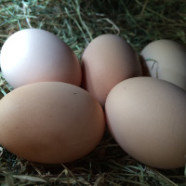Can technology fix our food system?
How can I use my skills in technology to help address the enormous problems with our food system today? I have been contemplating this question for more than a year, attending conferences, meeting farmers, and developing software. I have been humbled by the enormity of the problem and the unforgiving environment that farmers must work within. Not only do farmers have to contend with the vagaries of Mother Nature, they must also deal with the powerful external forces of government policy and consumer demand. To understand our current food system, we first need to understand the influence of government policy. As Scott describes in Seeing Like a State, historically governments relied on plentiful food to feed their projects, from better housing and sanitation to wars and military forces. Unfortunately, policies subsidizing cheap and unhealthy food are fueling an obesity epidemic. Michael Pollan and others recently proposed replacing our outdated U.S. farm policy with a food policy that promotes ecological stewardship, rural communities, and good nutrition. Technology cannot directly solve the policy problem, but information technology can help educate citizens about food. Online communities support those who want to learn to garden or raise chickens. Garden sensors such as Edyn help people get started gardening. People who know where their food comes from will demand better policies from their government. Much of agricultural technology has focused on increasing yield and decreasing costs of commodity crops with little regard to the health of the land and people. With half of Iowa’s topsoil lost in the last century and a surge in childhood obesity fed by cheap corn, we must look beyond short-term yield and price and focus on the broader long-term impact to society and the environment. Many farmers would like to use more sustainable agricultural practices, but feel consumers are unwilling to pay the premium for higher quality and more responsibly farmed food. Fortunately there is a growing body of consumers who are demanding more nutritious food and sustainable farming practices. Startups are popping up to helps farmers meet this demand and accelerate the growth of organic and sustainable agriculture. For example, CSA software such as Farmigo directly connects farmers with consumers who want fresh local produce. Goodeggs delivers farm fresh food directly to your home. Other companies are developing new technologies for producing biochar, which can increase yields at low cost while sequestering carbon to combat climate change. Better sensors and farm management tools reduce waste and help farmers make better decisions. To paraphrase Costa in The Watchman’s Rattle, we need to attack a complex problem from many different directions to have any hope of success. Technology alone cannot remake our food system but it must be part of the solution. By developing better software for farmers, gardeners, and those with backyard chickens, I hope to make a positive impact. I am encouraged by the tremendous growth in investment in agricultural technology. With global food demand predicted to increase 50% by 2050 and climate change underway, we will need all the help we can...
Read MoreHow I saved hundreds of dollars by tracking my eggs and feed
Some of the first questions that you get when you raise chickens are, “How many eggs do you get?” and “How much does it cost you per egg?” You may know how many eggs you got yesterday, or the day before, but do you remember how many you got last week? Or last winter? And just how much did you spend on feed last month? Your flock changes all the time, eating and laying less in the winter and more in the summer. You may add new chicks or hens to your flock, or lose some to predators or disease. At the end of the day you may not be sure whether you have the right number of chickens for the number of eggs you want. Maybe you got a new feeder or let them free range more. Do you know how this is affecting the health and productivity of your flock? I started to wonder about these questions myself. I recently found Scratch and Peck organic feed at my local feed store. It’s expensive but my chickens love it and I’m happy that I’m supporting sustainable agricultural practices. Are my chickens laying more eggs? And how quickly do they go through a bag of feed? I started recording this information so I can answer such questions. Tracking egg production and feed consumption can also help you identify pest problems. A few months ago I poured about 15 pounds of feed into the feeder before going on vacation for a few days. I was alarmed when I came back to an empty feeder and hungry chickens! I had noticed some rat droppings around my chicken coop before but I hadn’t realized just how big a problem it was. I did some research on backyardchickens.com and decided to get a treadle feeder from The Carpenter Shop. It has successfully kept the rats out and now I notice a lot less wasted feed. When I did the math, I realized this adds up to hundreds of dollars of savings in reduced feed costs! Tracking eggs and feed can make a big difference in the health of your chickens and help you quickly identify problems with diseases and pests, but it also requires that you be diligent in your record keeping. It can be a pain to remember and keep track of exactly how many eggs you got and how much feed you gave your chickens. Many other chicken owners track information about their flock but all the apps and spreadsheets I found were cumbersome and not so convenient. I decided to develop a fun and easy way to track my chickens and make it available to everyone. You can find more information at FlockPlenty Chicken Egg Tracker App. I hope you find it as useful as I do. Wishing you happy and healthy...
Read More




Recent Comments